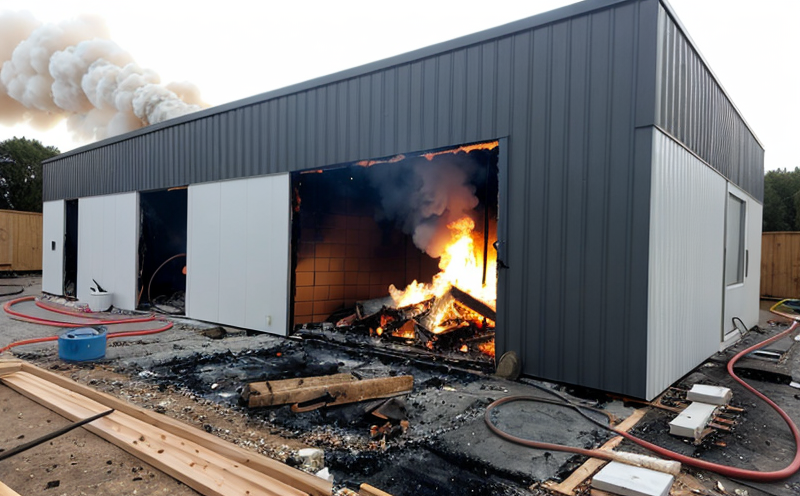Heat Release Rate Testing of Insulation Materials
The heat release rate (HRR) testing of insulation materials is a critical aspect in ensuring fire safety and compliance with international regulations. Heat release rate measures the amount of heat energy released by a material during combustion, which directly impacts its flammability characteristics.
Insulation materials are widely used in various sectors such as construction, automotive, and aerospace due to their thermal insulation properties. However, when exposed to fire, these materials can pose significant risks if they do not meet stringent safety standards. HRR testing provides a quantitative assessment of the material's flammability behavior under controlled conditions.
This test is particularly important for specifying materials that will be used in high-risk environments such as commercial buildings and aircraft interiors where even small flames could have catastrophic consequences. By conducting this test, manufacturers can ensure their products meet or exceed regulatory requirements while also protecting end-users from potential hazards.
The test involves subjecting a specimen of the insulation material to controlled heating until it reaches its ignition point. During this process, various parameters are monitored including temperature rise, mass loss rate, and heat release rate itself. These measurements provide valuable insights into how quickly the material will ignite once exposed to fire, as well as how rapidly it releases heat energy during combustion.
Accurate HRR testing is essential for determining appropriate flame retardant additives or other modifications needed to improve a material's performance in terms of fire resistance. It also helps identify any weaknesses within the manufacturing process that may contribute to increased flammability risks.
In summary, heat release rate testing plays an integral role in safeguarding lives by preventing fires caused by poorly designed insulation materials. Through precise measurement techniques and adherence to relevant standards like ISO 56602-1 & -2, laboratories ensure reliable results that can be used confidently across multiple industries.
Applied Standards
| Standard Number | Description |
|---|---|
| ISO 56602-1 & -2 | Methods for Determining the Heat Release Properties of Materials Used in Furnished Interiors (Parts 1 and 2) |
| ASTM E947 | Standard Test Method for Calculation of Combustion Characteristics from Measured Heat Release Rate Data |
| EN 458-6 | Test Methods for Textiles Used in Furnished Interiors - Part 6: Determination of Flame Spread and Heat Release Rate |
The application of these standards ensures consistent testing methods across different laboratories, thereby enhancing the reliability and comparability of results. These international guidelines provide a framework for accurate measurement, data collection, and interpretation of heat release properties, making them indispensable tools in fire safety testing.
Scope and Methodology
The scope of HRR testing includes evaluating the flammability characteristics of insulation materials under specified conditions. This involves measuring key parameters such as peak heat release rate (PHRR), total heat released (THR), mass loss, and smoke production.
- Specimen Preparation: Samples are cut into standard dimensions according to the relevant standard. For instance, EN 458-6 specifies specimen sizes of 100 mm x 200 mm for textiles used in furnished interiors.
- Instrumentation: Tests are conducted using a cone calorimeter or equivalent equipment that can accurately measure heat release rates over time. These devices typically consist of an ignition source, a sample holder, and a gas flow system to control the environment during testing.
- Data Collection: During the test, multiple sensors monitor various aspects including temperature, pressure, oxygen concentration, and smoke density. This data is then processed to calculate important metrics related to flame spread behavior.
The methodology ensures that all relevant factors influencing a material's flammability are accounted for in the testing process. By following these standardized procedures, laboratories can provide accurate and reproducible results that are essential for compliance with regulatory requirements.
International Acceptance and Recognition
- ISO 56602-1 & -2: Widely accepted by countries around the world, these standards have been endorsed by organizations such as NFPA (National Fire Protection Association) in the United States.
- ASTM E947: Recognized globally for its contribution to understanding combustion characteristics through heat release rate data analysis.
- EN 458-6: Used extensively within European Union member states and neighboring countries as part of their fire safety regulations.
The widespread adoption of these standards reflects their importance in ensuring consistent quality across different geographical locations. Laboratories accredited to perform HRR testing according to these guidelines are trusted providers of reliable data that can be used confidently by regulatory bodies, manufacturers, and end-users alike.





